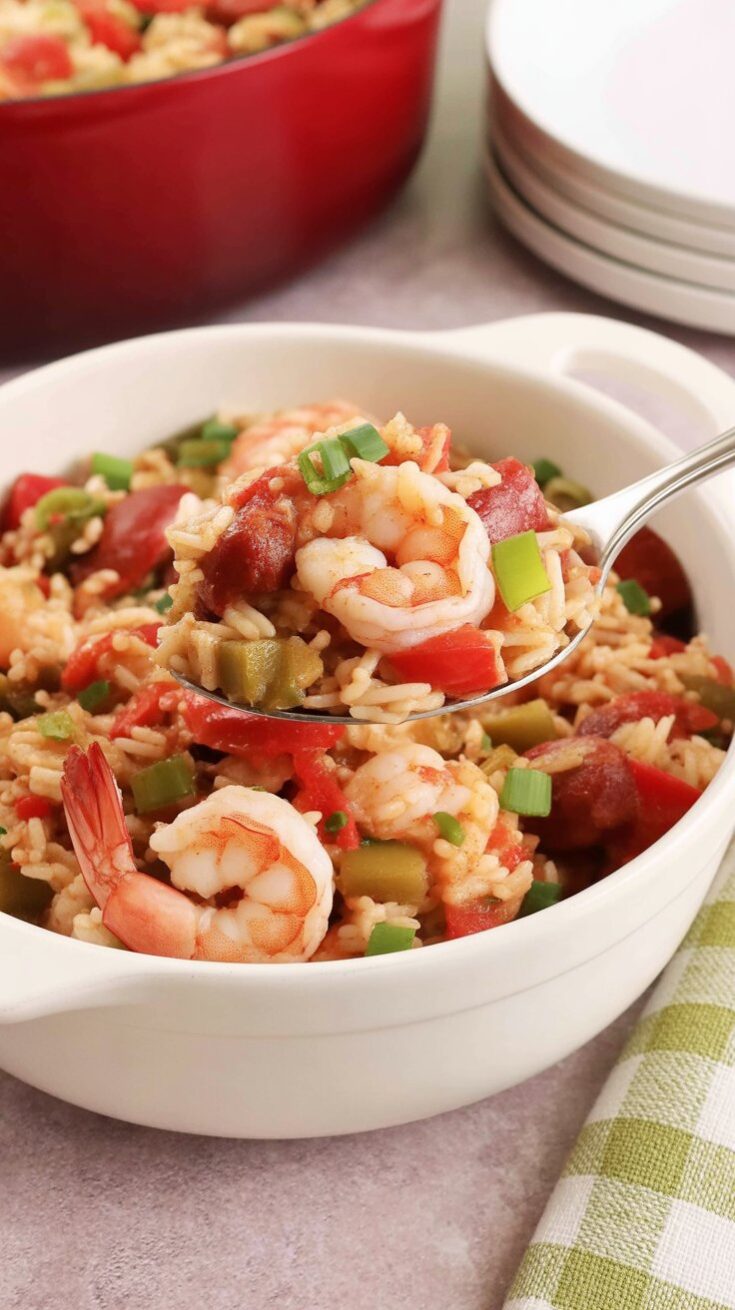There are few dishes that bring people together around a table quite like a big pot of seafood jambalaya. The steam rising from the pot, the deep flavors of shrimp, sausage, chicken, and Creole seasoning filling the air — it’s the kind of meal that feels like a celebration, whether you’re making it for Mardi Gras or just a regular Tuesday night.

The first time I cooked jambalaya at home, I was nervous about getting it right. I’d watched it being made at a friend’s family gathering in New Orleans years ago. They cooked it in this giant pot in the backyard, with neighbors coming over just to “check on the pot” (which really meant sneaking a taste). That memory has stuck with me — the laughter, the smell of sausage sizzling, the rice soaking up every bit of flavor. Now, whenever I make jambalaya, I try to capture a little of that feeling.
Why You’ll Love This Recipe
This Creole seafood jambalaya is a recipe I turn to when I want something bold, hearty, and deeply satisfying. It’s easy to make in one pot, feeds a crowd, and tastes even better the next day.
-
Big flavor, simple steps: Layers of sausage, shrimp, and chicken simmer with rice and spices for a dish that tastes like it’s been cooking all day.
-
Make-ahead friendly: The flavors deepen overnight, so it’s a great dish to prep ahead for parties or busy weeks.
-
Feeds everyone: Perfect for family dinners, potlucks, or casual get-togethers.
-
Authentic Creole flair: This is the kind of dish you’d expect to find along the Gulf Coast — soulful and generous.
A Little History: Where Jambalaya Comes From
Jambalaya has its roots in the rich, multicultural food traditions of Louisiana. It draws inspiration from Spanish paella, West African rice dishes, and French cooking techniques, all blended with local ingredients. Over time, it became a signature Creole dish — one that could be made with whatever protein was available, from sausage and chicken to shrimp, crab, or even wild game.
This flexibility is one of the things I love most about jambalaya. It’s a dish that tells a story of a place and its people — a story written in bold flavors.
Ingredients You’ll Need
This recipe uses a mix of seafood, meat, vegetables, and spices to build flavor from the ground up.
-
Shrimp: Juicy, plump shrimp are added at the end so they stay tender. I usually go for medium or large shrimp and remove the tails for easier eating.
-
Boneless chicken thighs: They stay moist and flavorful during cooking, unlike breasts which can dry out.
-
Andouille sausage: This is where that signature smoky, spicy flavor comes from. When it browns in the pot, it releases oils that season everything else.
-
Holy trinity vegetables (onion, green bell pepper, celery): These three form the heart of so many Creole dishes. You’ll smell the difference as soon as they hit the pan.
-
Garlic: Adds a savory base note that ties everything together.
-
Creole seasoning: A blend of paprika, garlic powder, onion powder, cayenne, oregano, and thyme. It gives the dish its signature kick.
-
Thyme and tarragon: Dried herbs that layer in extra depth.
-
Long-grain white rice: It soaks up all the flavor without clumping or getting mushy.
-
Chicken stock: This is the flavorful liquid that brings everything together. Seafood stock works beautifully too.
-
Tomatoes: Fire-roasted diced tomatoes add a smoky, rich backdrop to the Creole flavors.
-
Olive oil: Keeps everything from sticking and adds richness.
I always keep a jar of Creole seasoning in the pantry, so when the craving hits, I can throw this together without a trip to the store.

Step-by-Step: How to Make Creole Seafood Jambalaya
-
Brown the meats
Heat olive oil in a Dutch oven over medium-high heat. Add the chicken and sausage, cooking until browned and fragrant, about 10 minutes. Remove and set aside. -
Cook the holy trinity
In the same pot, add onion, bell pepper, and celery. Sauté until softened and aromatic. Stir in thyme, tarragon, Creole seasoning, and garlic. Let the spices bloom in the heat — this builds your flavor base. -
Toast the rice
Add the uncooked rice to the pot, stirring it into the seasonings and vegetables. This step gives the rice a toasted, nutty undertone that makes the finished dish richer. -
Simmer everything together
Return the chicken and sausage to the pot. Stir in chicken stock and tomatoes, bring to a boil, then reduce to medium-low. Cover and let it simmer gently for about 20 minutes, stirring occasionally. -
Add the shrimp
Once the rice is tender and the liquid is absorbed, remove the pot from heat. Add the shrimp and stir. Let it sit covered for about 10 minutes. The residual heat will cook the shrimp perfectly without turning them rubbery. -
Serve hot
I like to top it with a little extra Creole seasoning or a sprinkle of chopped green onions for brightness.
My Personal Tips for Perfect Jambalaya
-
Prep everything first. Once you start cooking, things move fast. Having your ingredients ready makes the process smooth.
-
Don’t rush the browning. The sausage and chicken build the flavor base, so give them time to get golden.
-
Use the right rice. Long-grain rice holds its shape and doesn’t clump. It’s worth it.
-
Add shrimp at the very end. This keeps them soft and juicy. Overcooked shrimp will toughen quickly.
-
Let it rest. A few minutes off the heat allows the flavors to settle into the rice.
Make-Ahead and Storage Tips
Jambalaya is one of those dishes that tastes even better the next day.
-
To make ahead: Cook everything except the shrimp. Cool and refrigerate for up to 24 hours. When ready to serve, reheat on the stove with a splash of stock or water, then stir in the shrimp to cook.
-
Freezing: Store in freezer-safe containers for up to 2 months. Thaw in the fridge overnight before reheating.
-
Reheating: Warm gently on the stove, adding a bit of stock to keep it moist.
Variations to Try
-
All seafood: Swap out the chicken and sausage for crab, scallops, crawfish, or fish.
-
Shrimp and sausage only: A classic combo with plenty of flavor.
-
Different sausages: Kielbasa, chorizo, or Italian sausage can be used if you can’t find andouille.
-
A splash of wine: A touch of dry white wine before serving can brighten the flavors beautifully.
-
Extra aromatics: A bay leaf, tomato paste, or chopped green onions can add more depth.
What to Serve on the Side
This dish is hearty on its own, but pairing it with a few simple sides turns it into a real feast:
-
Breads: Southern cornbread, hush puppies, or Texas toast garlic bread.
-
Vegetables: Collard greens, fried okra, or grilled veggies.
-
Salads: Cucumber-tomato salad, spinach salad with apples and pecans, or a light slaw.
-
Desserts: Pecan pralines, praline cheesecake, or a scoop of pralines and cream ice cream.

FAQs
Can I use frozen shrimp?
Yes, just thaw them overnight in the fridge and pat them dry before adding to the pot.
Is this dish spicy?
It has a gentle kick from the Creole seasoning, but you can adjust the heat level to your liking.
What’s the difference between jambalaya, gumbo, and étouffée?
Jambalaya is a rice-based dish where the rice cooks in the same pot. Gumbo is a stew served over rice, and étouffée is a saucy, smothered dish, often with shellfish.
What is the “holy trinity”?
It’s a mix of onion, celery, and bell pepper — the base of many Creole and Cajun dishes.
Can I make it vegetarian?
You can! Skip the meats and use veggie stock, then add more veggies like mushrooms, zucchini, or okra.
Creole Seafood Jambalaya

This Creole Seafood Jambalaya is a soul-warming, one-pot classic loaded with juicy shrimp, tender chicken, and smoky andouille sausage.
Ingredients
- 1 tablespoon olive oil
- 1½ pounds boneless skinless chicken thighs (cut into 1-inch pieces)
- 1 pound andouille sausage (sliced)
- 1 large white or Vidalia onion (chopped)
- 1 large green bell pepper (chopped)
- 3 celery stalks (chopped)
- 3 cloves garlic (minced or grated)
- 1 tablespoon Creole seasoning
- 1 teaspoon dried thyme
- 1 teaspoon dried tarragon
- 1½ cups long-grain white rice (uncooked)
- 3 cups chicken stock
- 29 ounces canned diced fire-roasted tomatoes (undrained; 2 x 14.5 oz cans)
- 1 pound extra-large shrimp (21–25 per pound, peeled and deveined, tails removed)
Instructions
- Heat olive oil in a large Dutch oven over medium-high heat. Add the chicken and sausage, cooking until browned on all sides, about 10 minutes. Stir frequently to prevent sticking. Once cooked, transfer the meat to a bowl, cover loosely, and set aside.
- In the same pot, sauté the onion, bell pepper, and celery in the pan drippings for about 5 minutes. Stir in the Creole seasoning, thyme, and tarragon, and cook for another 5 minutes. Add the garlic and cook for 30 seconds, stirring often to release the flavor.
- Add the rice and toss well so each grain is coated in the seasoning. Cook for 3 minutes to let it absorb the flavors. Return the chicken and sausage to the pot, then pour in the chicken stock and tomatoes. Stir everything together and bring to a boil.
- Once boiling, give it another stir, cover the pot, and reduce the heat to medium-low. Let it simmer for about 20 minutes, stirring occasionally to keep the rice from sticking.
- Remove from the heat and gently stir in the shrimp. Cover the pot and let it rest for about 10 minutes. The residual heat will perfectly cook the shrimp without overcooking them.
- Fluff the jambalaya gently before serving and enjoy it hot with your favorite Southern sides.
Nutrition Information
Yield
8Serving Size
1Amount Per Serving Calories 508Total Fat 27gSaturated Fat 8gTrans Fat 0gUnsaturated Fat 16gCholesterol 261mgSodium 1826mgCarbohydrates 22gFiber 3gSugar 7gProtein 45g
Easy Shrimp Recipes.com, occasionally offers nutritional information for recipes contained on this site. This information is provided as a courtesy and is an estimate only. This information comes from online calculators. Although allchickenrecipes.com attempts to provide accurate nutritional information, these figures are only estimates.
Final Thought
Creole seafood jambalaya is one of those dishes that makes your kitchen feel alive. It’s colorful, fragrant, and layered with flavor. Every spoonful has a bit of sausage, shrimp, chicken, rice, and spice — all working together like they’ve known each other forever. Whether you’re cooking for a crowd or just want a warm bowl for yourself, this jambalaya brings a taste of Louisiana right to your table. It’s not fussy, it’s not complicated — it’s comfort in a pot.

